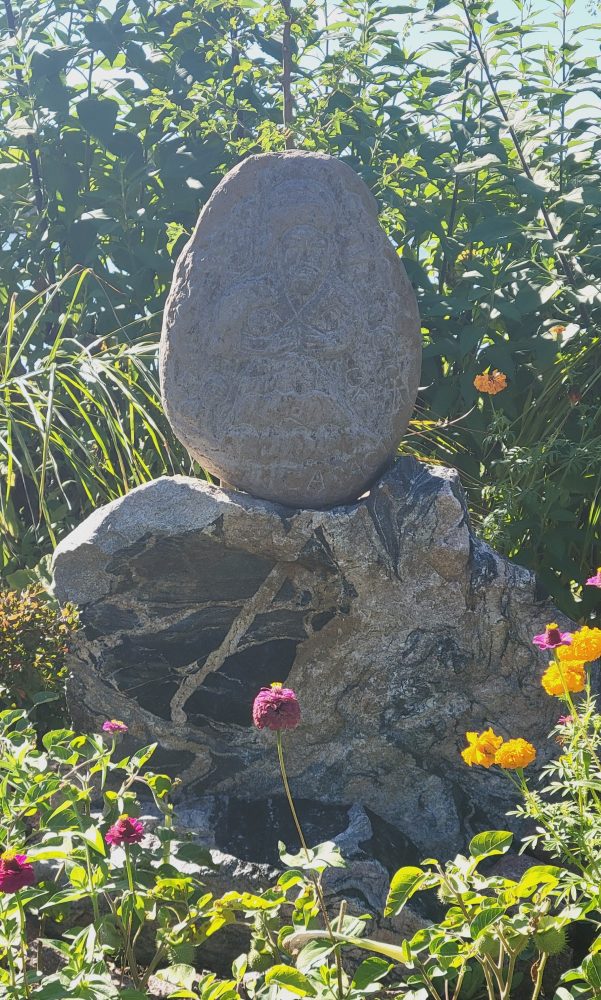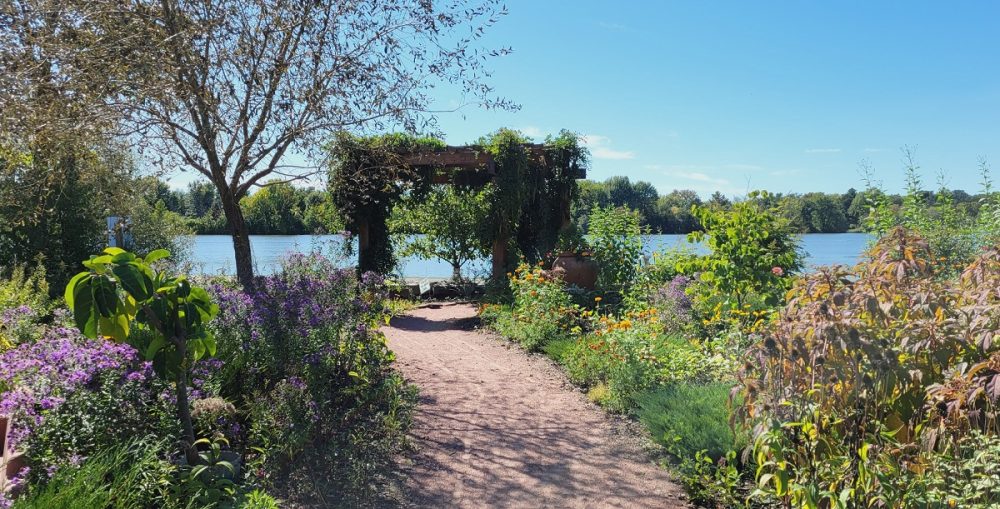A public, interpretive park sits on the banks of the Wisconsin River in Stevens Point, filled with lush plants, sculptures, rock formations and artifacts from around the world.
Located within Pfiffner Park, the Cultural Commons interactive garden exists to connect people and other cultures, specifically those of Stevens Point’s sister cities and of the native Menominee tribe who once lived on the riverbank. It was designed by University of Wisconsin-Stevens Point Interior Architecture Professor Aaron Kadoch.
“The Commons is a symbol of a community that is open to diversity and the park enables cultural experience through the landscape,” Kadoch said. “It embodies multiculturalism with a sense of place.”
Kadoch became involved in the project about six years ago when it began as an idea between the leaders of three community organizations that connect Stevens Point with its sister cities: Rostov Veliky, Russia; Gulcz, Poland; and Esteli, Nicaragua.
 This rock sculpture, created by Alberto Gutierrez, contains stones from Esteli, Nicaragua.
This rock sculpture, created by Alberto Gutierrez, contains stones from Esteli, Nicaragua.
Along with Susan Zach with the Russia Sister City Project, Leon Ostrowski with the Polish Heritage Awareness Society and Amy Wiza with the Wisconsin/Nicaragua Partners of the Americas, Inc, Kadoch began brainstorming concepts for a commemorative park, symbolic of a peace sign and the Rotary sign; that of a gear of community. The Rotary Club of Stevens Point got involved to help with fundraising.
“The timing was perfect because the group was looking for a project to celebrate their centennial in 2017,” Kadoch said. “With their input, the garden added an aspect of celebrating Stevens Point’s culture and history as well as a global perspective, adding energy and enthusiasm to the project.”
Within a few years, a larger team of stakeholders was formed, including the city of Stevens Point, and the design became finalized. The garden was funded completely by donations and was completed and dedicated in 2020. Many local contractors, builders, suppliers and services were used, with plaques at the commons naming all those who contributed. The stones that cover its winding paths carry names that honor or memorialize Stevens Point residents. Master gardeners added plants that represent both local and sister city plants, which volunteers continue to maintain.
In its center is a symbolic sculpture of a Menominee ricing canoe by John McDonald and Margaret Kettle. Within the Polish section of the garden, a sculpture titled “For Your Freedom and Ours” features two eagles, representing Poland and the United States. It was created by Boleslaw Kochanowski of Junction City.
The landscape and structures of the park represent the environments of the sister cities. On the north side of the circle, Kadoch designed a tower for a bronze bell cast in Rostov Veliky, by its mayor. Several pergolas and rock formations are set in the middle and west side of the park, representing the mountainous region of Esteli. A central rock formation was created with local stone by Kadoch and an oval rock carving by Alberto Gutiérrez was carried down from the mountains near Esteli by visitors from Stevens Point. The Polish section is a natural riverscape.
Phase two of the project, an outer ring, includes plans for more cultural connections with an educational focus, through an outdoor classroom, a labyrinth, and more interpretive sculptures.
Kadoch’s professional work and research is in community-based design and communication theory. Before coming to UWSP in 2011, he worked professionally in architecture, landscape architecture, and land planning in Madison, Vermont, the Twin Cities and New York city. He now teaches both traditional interior architecture courses as well as sustainable design, which has included students of all majors working on projects in community-based design.
“I am interested in collaborating more with students and faculty in UWSP’s College of Natural Resources as well as geography and geology to create cross-disciplinary courses in environmental design and landscape architecture,” he said.
“Community-based design looks at the whole community as a client, creating something that benefits everyone,” Kadoch said. “Our infrastructure is aging, so we need to design for environmental and social sustainability. Community-based design looks at what we need for the future.”
Kadoch hopes that visitors to the Cultural Commons find ways to make multicultural, local, and global connections.
“Even if you don’t know all the symbolism, you can experience it and enjoy the diversity of the ecological and architectural aspects of the park,” he said.
“It’s beautiful in every season. You can’t see it all at once – you have to wander, meander and explore it to find all the details.”
 Enjoy a view of the Wisconsin River at the Cultural Commons, a multicultural landscape in Stevens Point.
Enjoy a view of the Wisconsin River at the Cultural Commons, a multicultural landscape in Stevens Point.
